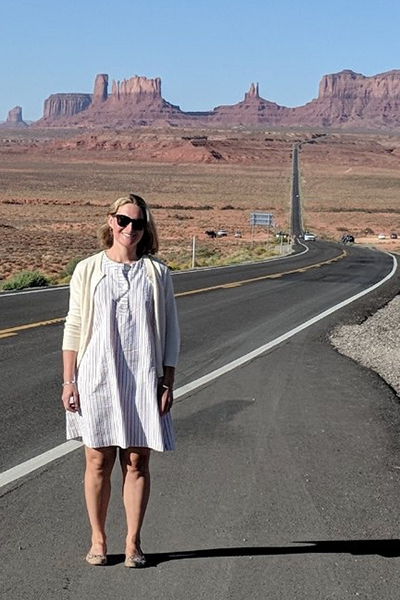$1.3M NSF Grant Awarded to ITLS Professor to Foster STEM Awareness in Navajo Nation Children

Dr. Kristin Searle, associate professor in Instructional Technology and Learning Services
Kristin Searle, associate professor in Instructional Technology and Learning Sciences in the Emma Eccles Jones College of Education and Human Services, is part of a collaborative research team that was recently awarded a combined $1.3M three-year grant funded by the Innovative Technology Experiences for Students and Teachers program at the National Science Foundation (NSF). The project aims to foster STEM career awareness among young Navajo children and will draw on the expertise of researchers at USU and Boston College as well as the Navajo Nation community and members of the Red Mesa Unified School District in Red Mesa, Arizona.
“In addition to direct benefits to Navajo children, this research will have direct benefits for Navajo and eventually Boston area community members, due to the culturally responsive nature of Professor Searle’s work,” says Andy Walker, ITLS department head. “These efforts are built on years of showing up for and with communities both before and after the grant work.”
Searle, who holds a dual doctorate from the University of Pennsylvania in education and anthropology, uses methods of anthropology to study culture and learning specifically in the areas of science, technology, engineering, and math (STEM).
“When we teach STEM in schools, it often doesn’t make sense to students from different cultural groups; it’s at odds with their cultural beliefs,” Searle explains. “We want to blend those two things. We want the children to see that they can be both Navajo and someone who does STEM. There are strengths in each of these world views and we want to see how they could come together.”
The focus of the project will be curriculum and a complementary “maker” cart, which is a common feature in early-childhood classrooms that generally contains multiple buckets for storing creative components like colored pompoms, goggly eyes, paint supplies, playdough, etc.
Searle explains the special maker cart they will create. “We’re going to make a series of twelve lessons and design a cart that contains the usual items, plus some technology such as preprogrammed microcontrollers and alligator clips,” says Searle. “They will be developmentally appropriate for four- and five-year-olds—maybe a programmable circuit board that makes a light blink or a motor spin around. Essentially, it’s craft plus technology. The children will be learning concepts such as pattern recognition, cause and effect, and sequencing.

Dr. Kristin Searle views Navajo Nation landscape in Northern Arizona
To incorporate a career aspect into one of the lessons, the team envisions possible fieldtrips or guests visiting the classroom. “Maybe they’ll go on a fieldtrip to a solar farm that’s near the school and talk about how it works. Then the kids might construct a model of it,” suggests Searle. “Or we might have someone who works at the solar farm come talk to the class. Because the students are so young, it’s really just about awareness of STEM careers.”
In addition to the USU and Boston College researchers, the local design team from the Navajo Nation will comprise nine members. “There will be three teachers, three parents, and three community cultural experts,” explains Searle. “We’ll work with the school district and with the local government to identify the appropriate community cultural experts.”
Members of the Navajo Nation will also help collect data in the classrooms. “I’m hoping to find some retired teachers or other members of the local community to train to collect data for us,” she says. “Those people will be Navajo, and they will have a different lens than the academic lens that I or one of my colleagues or students bring to the project.”
In the early phases, the project will reach nine early childhood educators and 100 Navajo children in the rural Red Mesa Unified School District, which is located near Teec Nos Pos on the Navajo Nation. In the third year, following testing, assessing results, and refining the cart and lesson materials, the researchers plan to broadly implement the cart and curriculum to teachers throughout the Navajo Nation and to educators in Boston.
“We will have designed this model that’s very specific to one school district and a handful of rural Navajo communities within that district,” explains Searle. “We will be interested at that point in asking how we can make it more broadly applicable. What do other teachers on the Navajo Nation need to make it relevant to their classrooms? And how do teachers in Boston, who might teach African American or Latino students, adapt the materials to make sense for their context?”
Searle hopes early childhood educators will find value in the curriculum the team develops for their classrooms. “One of the ways I measure success is if the teachers are interested in doing the lessons after the project ends,” she says. “Will they use these materials in the classroom? Even if they pick up one tool or technology that they’re excited about—if just one of those lessons sticks for them—that to me is success.”
Ultimately, though, Searle has high hopes for the Navajo children who will be introduced early on to the possibility of a STEM career within the context of their own culture. “We want to connect young Navajo children to STEM education and introduce them to the possibility of a career in STEM that also makes sense from a cultural perspective. My goal is to design with our community partners technology tools and curriculum that make sense for these young Navajo learners.”

